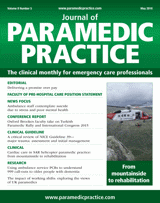References
A critical review of NICE Guideline 39—major trauma: assessment and initial management
Abstract
Major trauma is a leading cause of death in the under 40 years age group, and has a significant impact on morbidity, causing a financial burden to the National Health Service (
This article critically appraises the recommendations made by
In February 2016, the National Institute for Health and Care Excellence (NICE) published clinical guideline NG39, which focuses on the care of major trauma patients in England. The guideline provides recommendations for the initial assessment and management of major trauma patients in both the pre-hospital and in-hospital phase, and the flow of these patients through trauma networks. NG39 (NICE, 2016a) is supported by NG40: major trauma service delivery (NICE, 2016b) and a number of other specific guidelines on fracture management, complex fractures and the management of spinal injuries. This article focuses on reviewing and critical appraisal of the recommendations (Box 1) for pre-hospital care, the impact of these on the paramedic profession and ambulance services, and the future of major trauma care in England. It does not consider the specific care of burns patients, paediatrics or the elderly, as sub-sets of major trauma.
Subscribe to get full access to the Journal of Paramedic Practice
Thank you for visiting the Journal of Paramedic Practice and reading our archive of expert clinical content. If you would like to read more from the only journal dedicated to those working in emergency care, you can start your subscription today for just £48.
What's included
-
CPD Focus
-
Develop your career
-
Stay informed

